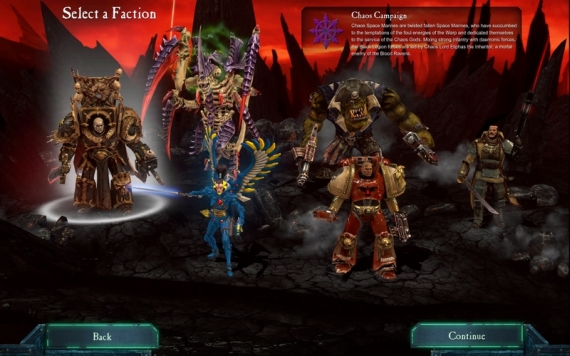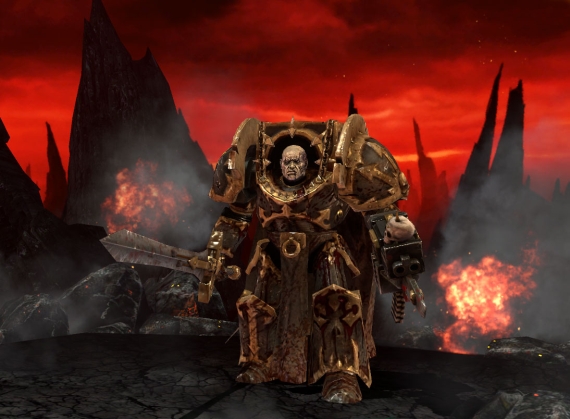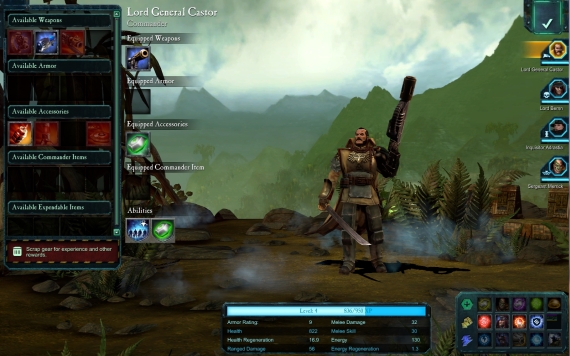Recently, GameReplays.org
member Tirranek attended a THQ
press event for the upcoming launch of Dawn of War 2: Retribution
. Relic
gave a few demonstrations to the assembled on a few finer points of the new game, before offering a chance at some proper playtime time with the new title. We asked Tirranek to write down some of his thoughts about his time with the single-player. With the multiplayer beta going live soon and all the inevitable data crunching that will ensue, it seems a little bit pointless to try and catalogue all the little bits of information I managed not to forget. Instead, I have decided to focus on some details of the singleplayer game, where I found myself spending the majority of my time.
During the games day we were given a very broad, thin slice of the game; think Battenberg cake. We were able to try all of the six races in a small number of missions, some from the very start and one major set-piece that occurs later on. Even with these limits on what we were able to see, there was a huge amount to take in.
First of all, we were shown a new sequence by Plastic Wax. It was quick, chaotic, and evoked many a giddy feeling. It's all snapshots of frantic action being shown from multiple perspectives. As an introduction to
Retribution, it is very appropriate; it captures a large part of how the game feels- many sides, all fighting furiously in a shared space, for their own ends.
Booting up the campaign brought back memories of Winter Assault for me, more so than Dark Crusade. You are presented with all six heroes, doing in time-honoured fashion the "Hey, look at me! I'm awesome" routine. Hovering over them reveals some very basic background information for those who might be unfamiliar with the lore, then it's a matter of leaping right into things. Being the inescapable ponce that I am, I went with the Eldar.
The opening cinematic is the same for every race. Gabriel Angelos gives a quick, suitably ponderous retelling of prior events. It recalls events not only from Dawn of War 2, but also the original franchise. Even with the bulk of the story unavailable to us, it felt as if the storyline in
Retribution was gathering up threads from all prior games with the express intent of moving them forward. It also made something clear from the start, that there is an over-arching narrative within which your chosen race maneuvers for their own purposes. While the missions we played were largely similar across the different races, the meta-narrative that unfolds makes it distinct to your race. This is made apparent in the very first mission, which to all intents and purposes serves as a tutorial. The structure is similar for any race you choose: move here, attack there, "we can use grenades to clear out that building," suppression is bad, mini-defense mission, boss fight. However, what isn't similar is how the choice of race puts a different spin on tactics, as well as how story plays out.
The boss you fight at the end of the first level isn't just some random enemy with lots of hit points, it's actually one of the other race's key characters. When you defeat them, they die- I mean, actually die. They lie there, gurgling their last words (as is the prerogative of any boss), cursing you and your pesky intrusion into their master plan before snuffing it permanently. You get a sense that events have been fundamentally altered by your involvement, and this is only the first level.
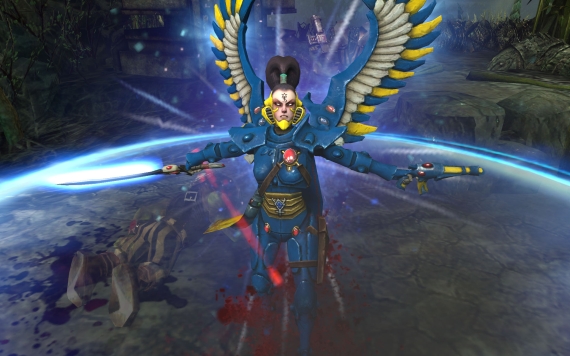
If I had any concerns about the campaign from a gameplay standpoint it, would be that the missions we were given were quite narrow with how to approach them. For all the personalized touches you can make with your army, a couple of the missions had an urgency to them which restricted how you were able to use them. In one you are running away from a Baneblade; in another, orbital lasers. Both instances add a sense of pressure that hurries you along, perhaps faster than you would like. It's unfair to apply this to the whole campaign at this point, however, since we were only shown a small number of missions and they were very much set-piece moments that occur at key-points in the plot.
A quick note on the various "flavour" of the races that I played. Watching the Eldar at work from behind the scenes is a lot of fun. While their loyalty to each other seems rarely in question, they certainly don't shy away from cutting away at each other with that most painful of weapons, the scathing remark. The inter-group 'politics' throughout a mission is fun to watch. While a faction like Chaos have a sense of doing the same thing for their own reasons, the Eldar have a sense of doing the same thing, for the same reasons, but often thinking their opinion is better. The only time there seems to be a true sense of unity amongst them is when they all come together to collectively jeer at an alien. It's all very fun.
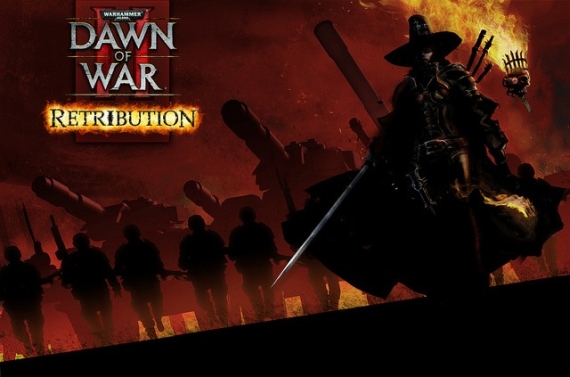
The Imperial Guard have a much more regimented feel to them, naturally. In the opening part of the first mission, Lord General Castor comes along, revives an injured Catachan Sergeant, then berates him aloofly for his silly, getting almost killed mistakes. In more ways than one, it's like the Imperial Guard is being led by General Melchett from Blackadder, who despite being more competent than his WWI counterpart, nonetheless imparts a mild sense of horror. Also, the Imperial Guard are still very much "British". Sgt. Merrick carries the torch of the old
Dawn of War 1 Imperial Guard voice, while others sound more in line with the Commonwealth forces in
Company of Heroes: Opposing Fronts. Castor is well-spoken and shows an understanding of battlefield strategy, albeit the comfortable war-room, somewhat removed from reality type of strategy. The Baneblade is driven by Scots. The inquisitor likes to burn things.
I found myself most surprised by the Marines. Since they're the ones we've been following from the beginning of the series, the ten year jump is felt most potently by playing them. Gone is the nameless force commander (along with his love of fury from all things misbegotten) and is replaced by Apollo Diomedes; all classical, all good. What is more jarring is the now fragmented roster of your team. Where is Tarkus and his pragmatic assessments? Where is Avitus and his low-throated bigotry? Relic's much sought after attachment to your troops comes across more potently through their absence than it ever did in previous games.
No matter what race you may find yourself picking, there is a distinct quality to them that colours the way the story unfolds. While our time with it was by no means exhaustive, things seemed very encouraging.
Now for the last major consideration of the singleplayer, the phat lewtz.
Dawn of War 2 made you fight many, many times, to obtain the best gear or reach the most coveted skills. It felt very much like the old MMO philosophy of long-term investment for reward.
Chaos Rising remedied this with better pacing and a greater abundance of options with the higher level ceiling and corruption mechanic.
Retribution on the other hand throws choices at you from the very beginning. What's more, they all seem to be good choices. It was far more than I was expecting. I'll take you through what I remember.
First there is the "well-done commander" pat on the back, giving me an item to augment one of the characters. Thank you for that, I think. Then I'm presented with a screen and three further choices. Hmm, I ponder. Do I want...:
A) A most shiny sword of killing for one of my commanders
B) A Warlock leader to augment my Guardian squads
C) Warp Spiders
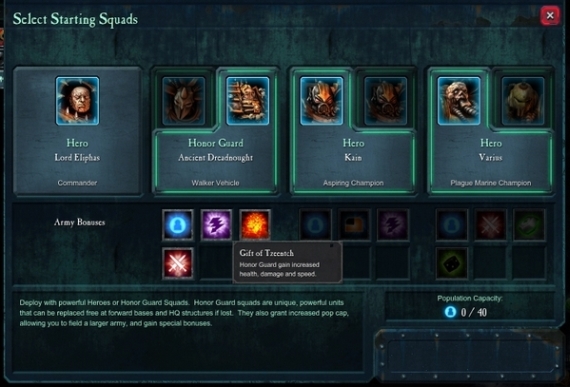
It took me awhile to decide. The sword was indeed very shiny, a blue item no less. If I passed on this now one of my melee focused leaders could be markedly less powerful. Then again, Warp Spiders. They're Warp Spiders. Yes, all right, I'll go with them....But the Warlock for my guardians. I do like Guardians, and I really like them when they don't die from a mildly-forceful sneeze. So in the end I actually go for what seems like the least exciting choice. Having chosen that I see a tab on the star-map that shows me the status of my army upgrades. I realize then that practically everything available in multiplayer, including unit upgrades, is potentially unlockable for your campaign playthrough. Then finally the familiar loadout screen becomes available. Again, things are familiar but notably different with Retribution. In addition to the race-specific loot, each experience point now feels sizable. There is no more padding out stats and waiting for an ability, every point has tangible results, and if you're stuck making a choice it's because you are presented with a number of very appealing abilities that buff your leaders to a considerable extent. Even if you decide not to take a commander with you on a mission, a number of skills you choose will passively buff your army. The essence of the game seems to be that it does not penalize you for playing the game how you want to play it. If you want to play with honour guard rather than squad-leaders, your investments will still pay off.
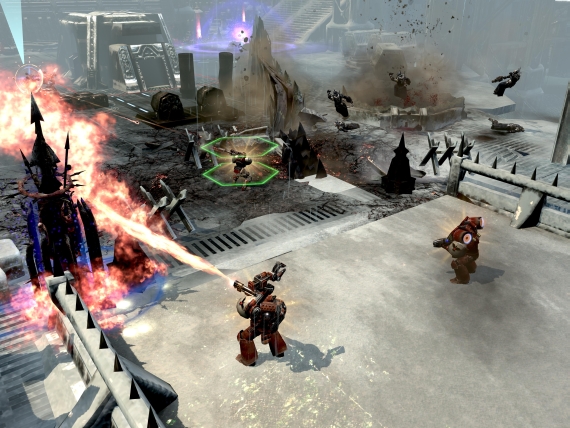
All in all, the singleplayer comes across as an antidote to the biggest complaints about the first two installments. If the range of circumstances throughout the missions are varied enough to give you as much choice on the battlefield as off it, then
Retribution looks set to be an amazing addition to the series.
Discuss this article in the discussion topic!

